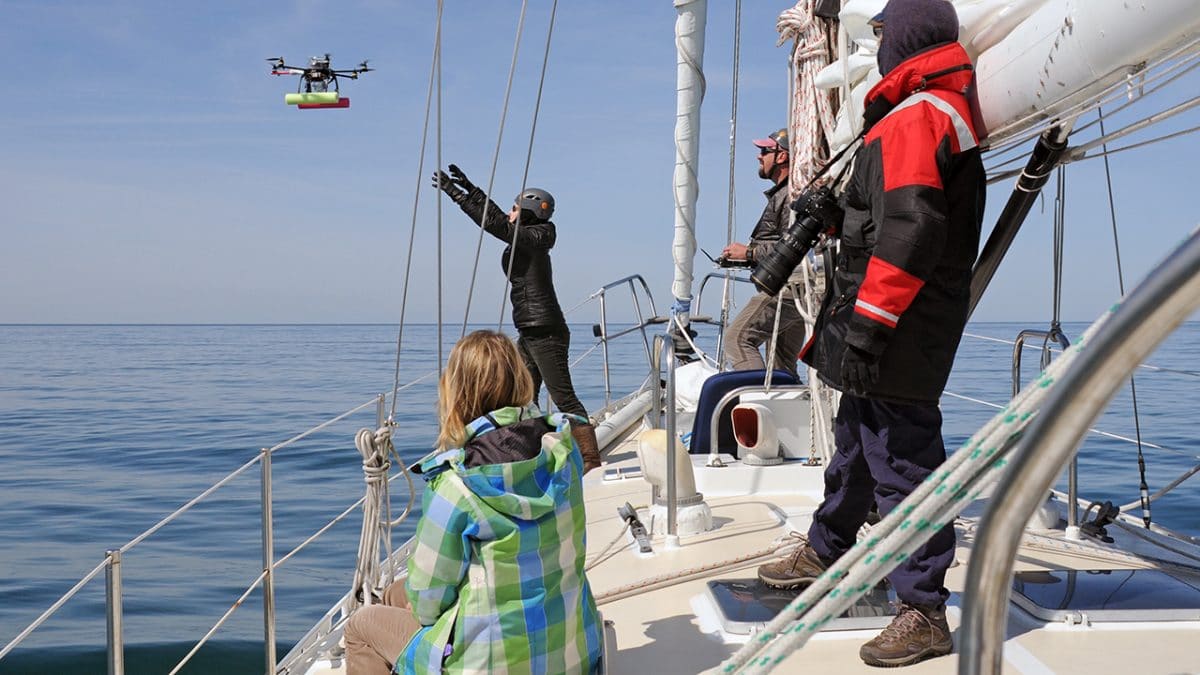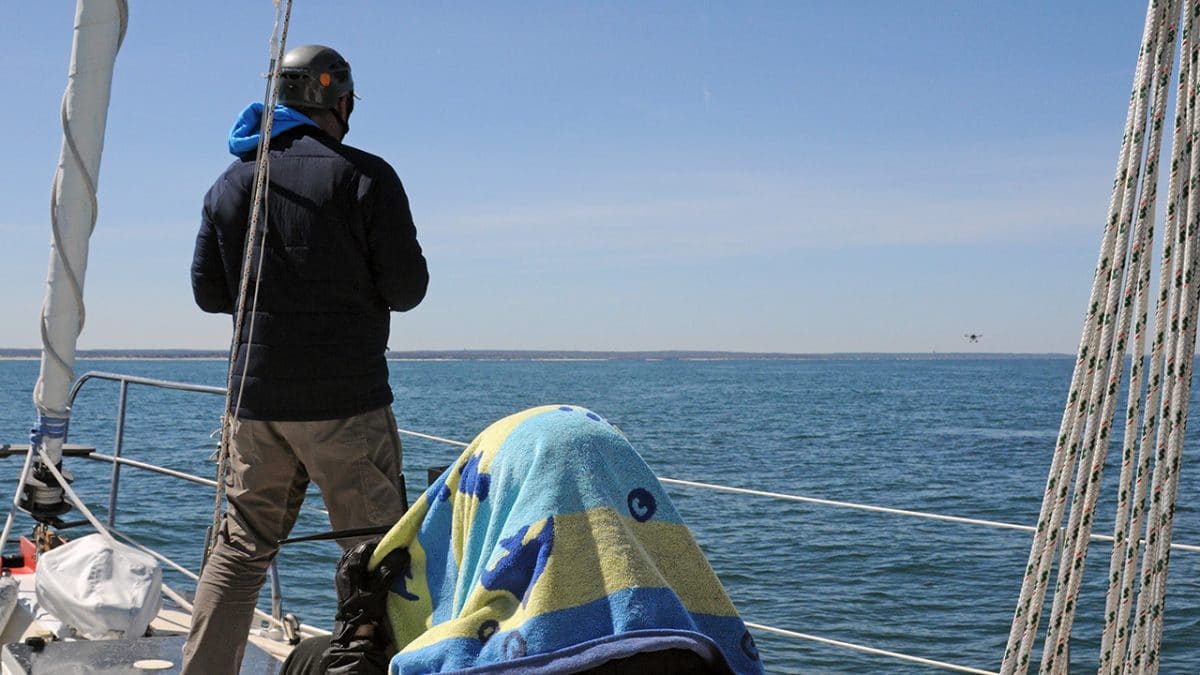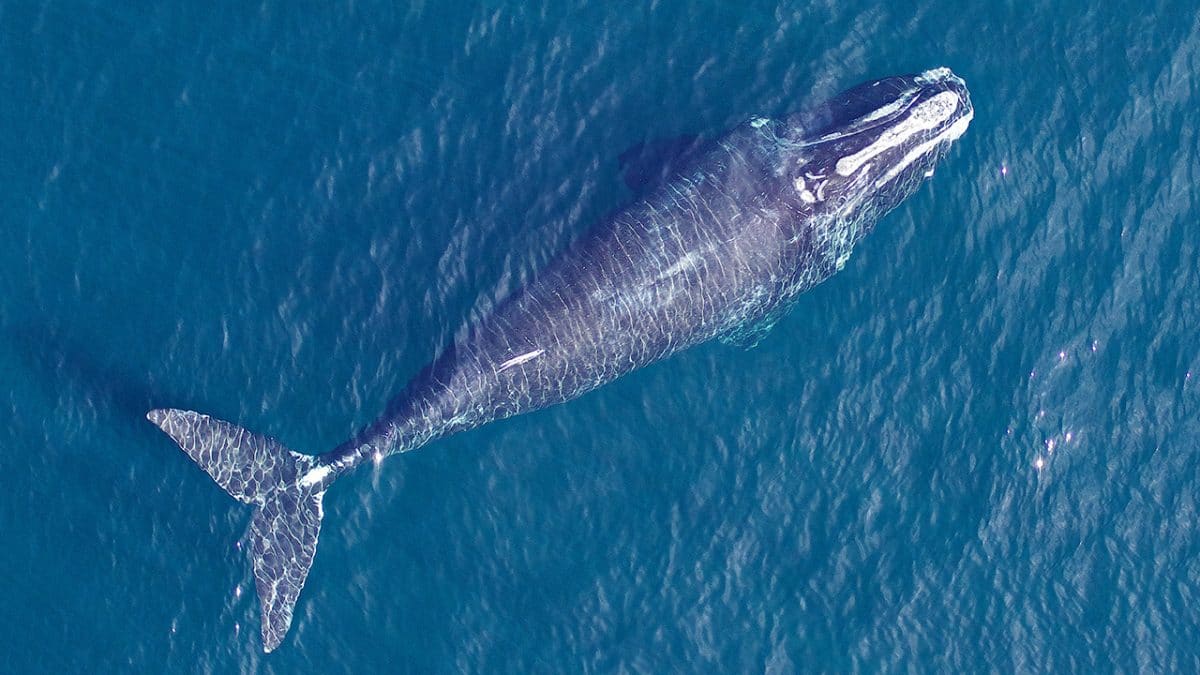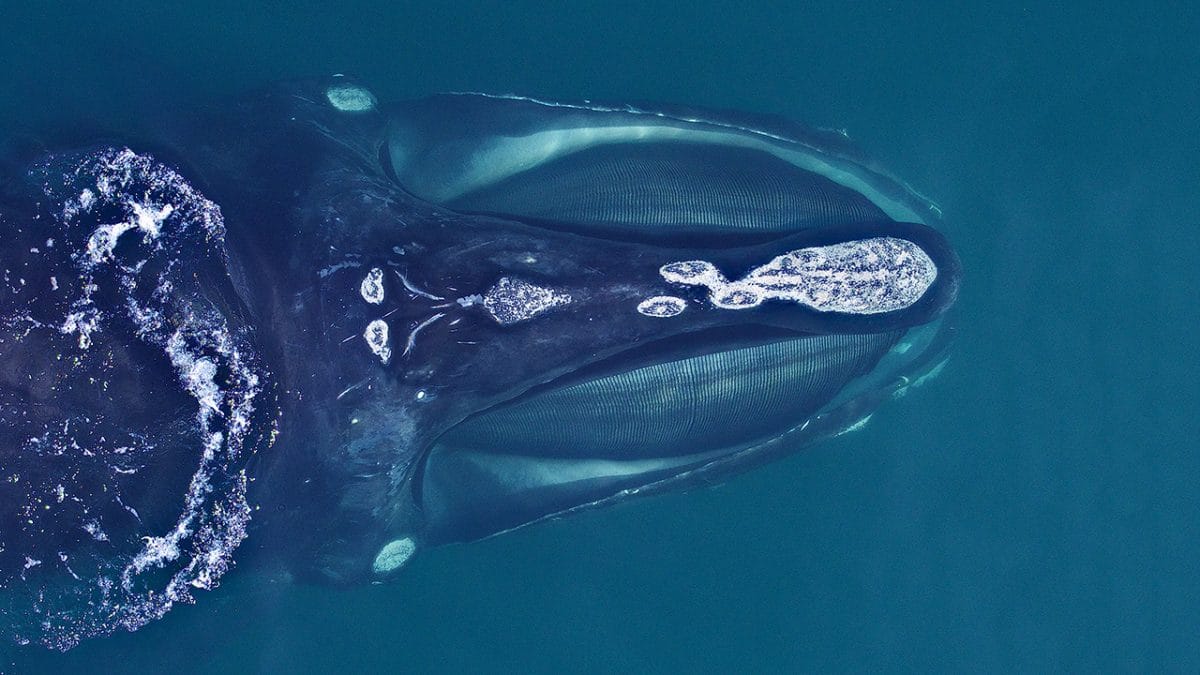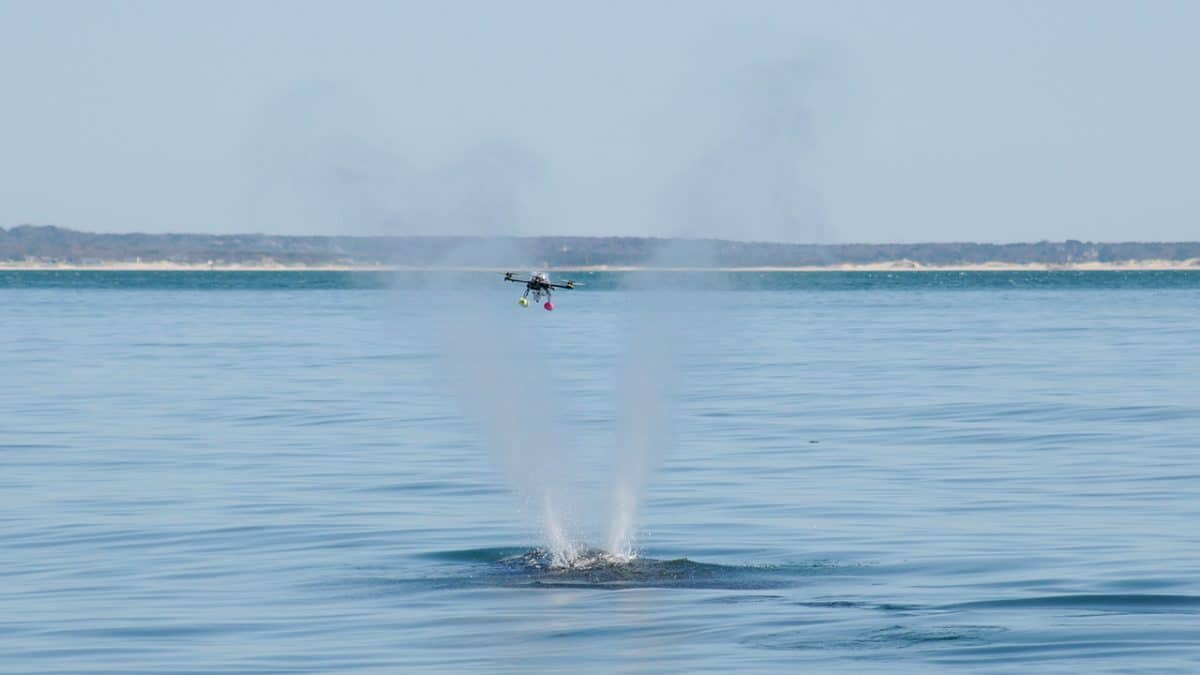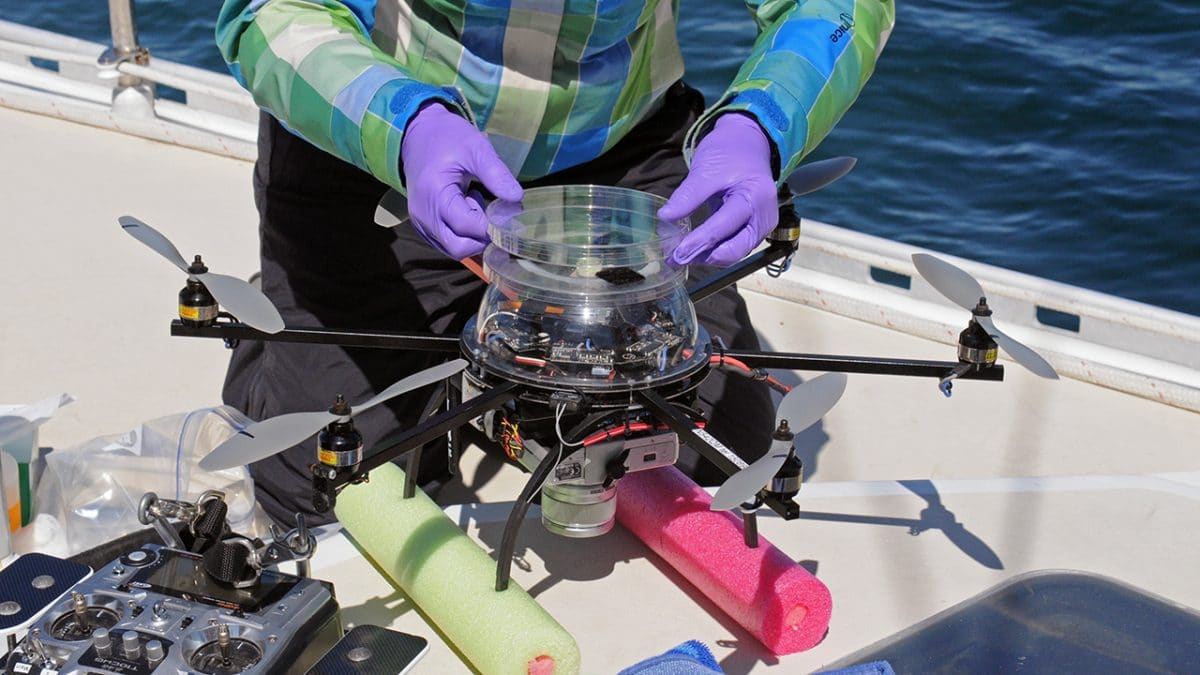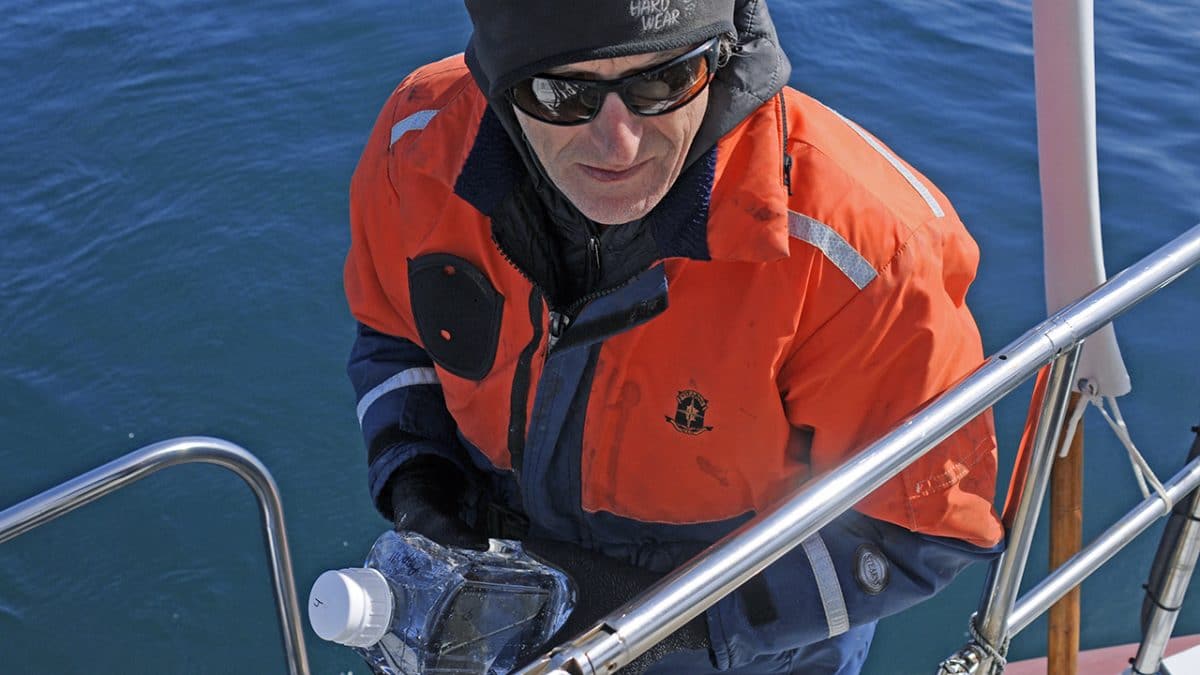- Drones are providing a powerful new tool for whale research and conservation. Here, NOAA’s John Durban (center rear) uses a remote control to guide a hexacopter into the outstretched hands of his NOAA colleague, Holly Fearnbach, as WHOI microbiologist Amy Apprill (seated) and New England Aquarium whale specialist Marilyn Marx look on. Durban makes it look easy, but maneuvering a drone from a rocking sailboat is anything but. (Photo by Véronique LaCapra, Woods Hole Oceanographic Institution)
- Sitting on the deck in the bright sunlight, Fearnbach uses a towel to shade a monitor screen showing a video feed from the drone’s camera. By looking at the video, Fearnbach sees what the camera “sees” in real time—and can tell Durban which way to fly the drone in order to position it over a whale to take high-resolution images and sample its blow. (Photo by Véronique LaCapra, Woods Hole Oceanographic Institution)
- In the past, getting aerial photographs of whales meant taking them from a plane or helicopter. A small drone equipped with a specialized camera can get close to a whale without disturbing it, resulting in images of unprecedented quality and detail. In a process known as photogrammetry, a team led by NOAA’s Wayne Perryman will use the images to estimate the size of the whales, assess their body condition, and draw conclusions about their overall health. Research approach of whales using the hexacopter was authorized by NMFS permit #17355 and flights were authorized under an MOU between NOAA and the FAA (Class G MOU #2016-ESA-3-NOAA). (Photo by John Durban and Holly Fearnbach, NOAA Southwest Fisheries Science Center, and Michael Moore, Woods Hole Oceanographic Institution)
- This close-up image was taken as the drone approached a whale to collect a sample of its blow; the animal's still-closed blowholes are visible as two slits in the center of its head. The whale is filter-feeding on tiny crustaceans near the surface of the water, so its mouth is open, revealing its baleen plates. High-resolution photographs like this one allow scientists to identify individual whales by their unique pattern of callosities—the patches of rough skin on the whale’s head. The dark callosities are covered with light-colored cyamids or “whale lice,” making them appear white. Research approach of whales using the hexacopter was authorized by NMFS permit #17355 and flights were authorized under an MOU between NOAA and the FAA (Class G MOU #2016-ESA-3-NOAA). (Photo by John Durban and Holly Fearnbach, NOAA Southwest Fisheries Science Center, and Michael Moore, Woods Hole Oceanographic Institution)
- The drone hovers in the whale’s blow to collect a sample. The V-shaped spray pattern is characteristic of baleen whales such as North Atlantic right whales, which have two blowholes through which they breathe. Whales with teeth—such as sperm whales—have only one blowhole. Research approach of whales using the hexacopter was authorized by NMFS permit #17355 and flights were authorized under an MOU between NOAA and the FAA (Class G MOU #2016-ESA-3-NOAA). (Photo by Véronique LaCapra, Woods Hole Oceanographic Institution)
- To get a sample of a whale’s blow, the researchers attach a sterilized petri dish to the top of the hexacopter. After a successful flight, they transfer the collected liquid to a small plastic vial and freeze it. Back at WHOI, Apprill and her colleague Carolyn Miller will use a technique known as metagenomics to analyze genetic material and identify microbes in the blow. (Photo by Véronique LaCapra, Woods Hole Oceanographic Institution)
- WHOI biologist Michael Moore collects a sample of seawater off the back of the boat. Apprill and Miller will compare the water’s microbial community to what they find in each blow sample, to distinguish microorganisms that live in the water from those specific to a whale’s respiratory tract. Respiratory system microbes are the most common source of disease in whales. (Photo by Véronique LaCapra, Woods Hole Oceanographic Institution)
Endangered Whales Get a High-Tech Check-Up
Drones give researchers an unparalleled view of marine mammal health
Scientists at Woods Hole Oceanographic Institution (WHOI) and the National Oceanic and Atmospheric Administration (NOAA) are studying the health of critically endangered whales—using drones. This spring, a research team led by WHOI biologist Michael Moore and NOAA researchers John Durban and Holly Fearnbach sailed out into Cape Cod Bay in search of North Atlantic right whales feeding just off the coast. They used a remotely controlled, six-rotor hexacopter to take detailed aerial photographs of the whales and collect samples of their “blow”—the moist breath that a whale sprays out of its blowhole when it exhales. Over the course of three weeks, the researchers completed 67 drone flights, photographing about 35 different whales and gathering 16 blow samples.
The photos you see here show the research team in action—and the amazing images the drone took of these rare whales, some of which are almost as long as the 55-foot sailboat used for the project.
The next step for the researchers will be to analyze the data they collected. Using the photos, Durban and Fearnbach will work with NOAA colleague Wayne Perryman to assess each whale’s size and body condition and to look for any injuries or scars. At WHOI, Carolyn Miller and Amy Apprill will sequence genetic material they find in the blow samples to determine what kinds of bacteria, viruses, and fungi make up the blow “microbiome.” By comparing blow samples from different whales—and different whale species—the researchers hope to figure out what the microorganisms in a whale’s respiratory tract can tell us about an individual’s overall health.
Understanding the health of North Atlantic right whales may prove critical to their survival: there are fewer than 500 of these animals left. They spend most of their lives within 50 miles of the East Coast of North America, making them vulnerable to human activities. Based on available data, more than half of right whiles die in collisions with ships or by becoming entangled in fishing gear. In addition, climate change and a warming ocean may be reducing their main source of food—tiny crustaceans called copepods—leaving some right whales undernourished and less able to reproduce.
Funding for this research project was provided by NOAA’s Northeast Fisheries Science Center’s Large Whale Team led by Peter Corkeron, through the Cooperative Institute for the North Atlantic Region (CINAR) Grant #NA14OAR4320158.
Related Articles
Featured Researchers
See Also
- Whither the North Atlantic Right Whale? Oceanus magazine article
- Tangled Up in Fishing Gear Oceanus magazine video
- Series: North Atlantic Right Whales Oceanus magazine special series
- NOAA: North Atlantic Right Whale NOAA Fisheries species webpage
- Whale Research Takes Flight WHOI news release

